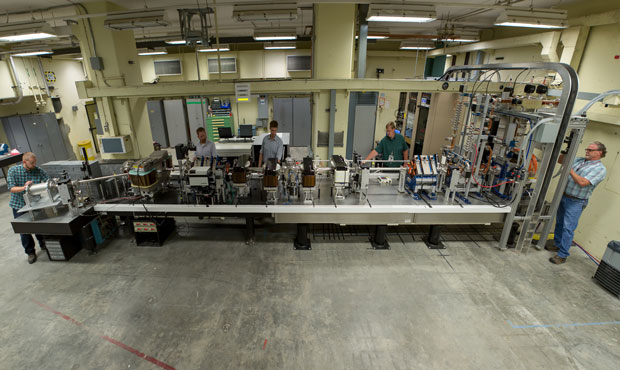Roark Marsh (15-ERD-067)
Project Description
A narrow-band x-ray source is ideal for a variety of applications that rely on the K-edge effect, which is related to the binding energy of the innermost electron shell (K shell) of an atom. For this interaction effect to occur, the source photons must have more energy than the binding energy of the K-shell electrons (K-edge) of the target material. Uses for such a source range from medical applications where an absorption edge in iodine injected into the bloodstream can significantly enhance the contrast of fine anatomical features to Livermore's National Ignition Facility target diagnostics, where detecting the shift in the K-edge of an atom as it ionizes could allow a spatial map of the ionization state in hot plasmas. Current and future generations of these advanced light sources largely depend on high-brightness electron beams. We plan to investigate the potential utility of Compton scattering of laser light to produce x-ray sources for radiography and diffraction measurements. We will study the physical and engineering limitations on brightness performance of a recently commissioned X-band linear accelerator at LLNL (see figure), and investigate x-ray production via Compton scattering using the system. We will determine limitations of both the peak and average brightness of the machine with respect to per-bunch emittance of x-rays and increasing the number of bunches the machine produces in a unique, closely spaced, multiple-bunch mode of operation.
The x-ray performance of a laser Compton light source is tied directly to the brightness of the electron beam or to increases in the beam current and reductions in the beam emittance. We expect to demonstrate, using a combination of modeling and experimental efforts, the viability of x-ray generation from multiple bunches in an X-band accelerator system, and investigate their utility for mission-related applications. Work will include upgrades to the Livermore X-band radio-frequency photo-injector and accelerator system for generating additional pulses. We will also measure an increase in the electron beam brightness and characterize the emittance of multiple-bunch x-ray beams, which will subsequently improve brightness of the x-ray source. In addition, we will model the electron and laser interaction to validate the expected system performance and cross-check beam simulations with measured results. The controls will be upgraded to improve the day-to-day operation of the machine, enhance its capabilities, and more quickly and robustly deliver x rays to users.
Mission Relevance
The capability developed under this project lays the foundation for a compact, time-resolved and potentially stroboscopic high-energy x-ray capability applicable to advanced laser light sources, and therefore aligns well with the core competency in lasers and optical science and technology at Lawrence Livermore. Ultimately, the technology developed could be incorporated to serve as a diagnostic on a high-energy drive system, such as Jasper or the National Ignition Facility at LLNL, to perform Laboratory mission-relevant measurements in high-energy-density research.
FY16 Accomplishments and Results
In FY16 we (1) generated narrow-bandwidth x rays using the X-band photoinjector, and the x rays have been characterized in close agreement with modeling predictions using measured electron beam parameters; (2) optimized x-ray flux and bandwidth to achieve this close agreement, which has led to record electron-beam performance; (3) upgraded controls for streamlined operation and automated data analysis; and (4) procured new hardware for planned upgrades to greater than 85-MeV electron-beam energy and greater than 250-keV x-ray energy.
Publications and Presentations
- Gibson, D., Multi-bunch operation of a laser-Compton x-ray source based on compact X-band accelerator technology. Compact EUV & X-Ray Light Sources Mtg., Long Beach, CA, Mar. 20–22, 2016. LLNL-CONF-680160.
- Gibson, D., et al., Compact X-band accelerator controls for a laser-Compton x-ray source. 7th Intl. Particle Accelerator Conf., Busan, Korea, May 8–13, 2016. LLNL-CONF-690727.
- Gibson, D., et al., Demonstration of multibunch operation from a compact laser-Compton x-ray source. Intl. Conf. on X-Ray Optics, Detectors, Sources, and their Applications (XOPT'16), Yokohama, Japan, May 17–20, 2016. LLNL-CONF-686517.
- Hwang, Y., et al., LLNL laser-Compton x-ray characterization. 7th Intl. Particle Accelerator Conf., Busan, Korea, May 8–13, 2016. LLNL-CONF-691080.
- Marsh, R.A., et al., LLNL X-band RF gun results. 7th Intl. Particle Accelerator Conf., Busan, Korea, May 8–13, 2016. LLNL-ABS-690706.






